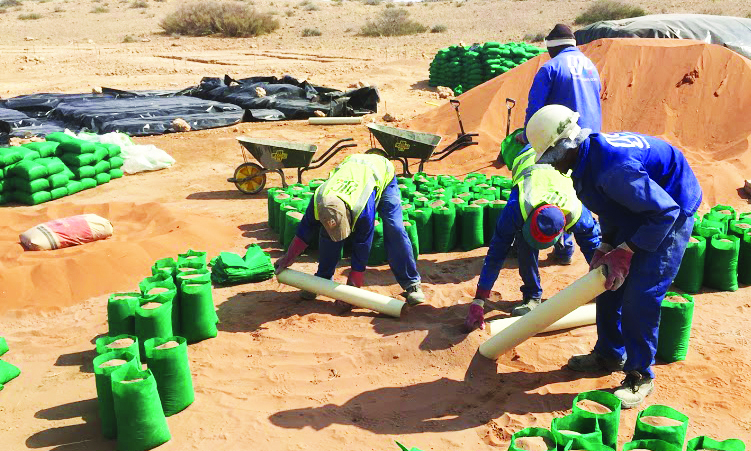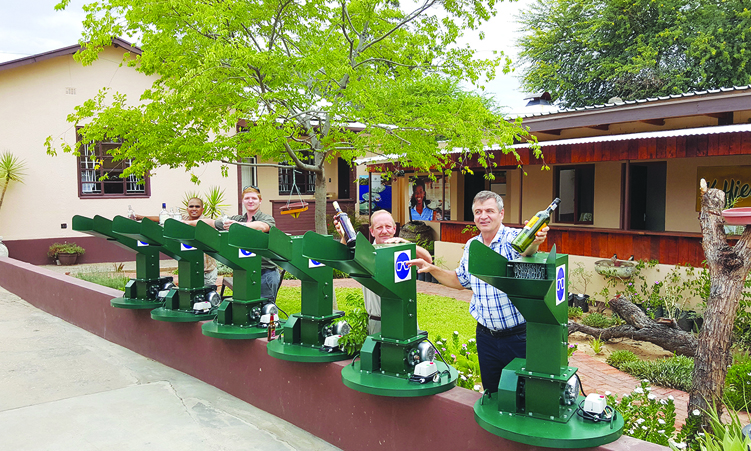Sustainability and environmental consciousness are critical to people’s lives and well-being.
However, for businesses, they provide an opportunity to drive transformation and innovation.
As tourism booms, the industry faces the challenge of balancing growth with self-sufficiency.
Here’s how Namibia is paving the way for a greener future, one innovative step at a time:
Namibia is commitment to conservation is enshrined in the constitution, making it the first country in Africa to do so.
Additionally, this is evident in its extensive network of national parks and conservancies.
The Etosha National Park, one of Africa’s premier wildlife sanctuaries, is home to a host of species, including endangered species.
This park, along with others, like the Namib-Naukluft Park and Skeleton Coast Park, plays a crucial role in protecting Namibia’s biodiversity.
Other initiatives include the Namibian Coast Conservation and Management (NAcoma) project, which focuses on preserving the unique coastal biodiversity and ecosystems. Additionally, the Integrated Rural Development and Nature Conservation (IRDNC) programme empowers communities to manage their natural resources sustainably, fostering both conservation and economic benefits.
Projects like the Cheetah Conservation Fund (CCF) and the N/a’an ku sê Foundation have also been pivotal, combining wildlife research, habitat restoration, and community education to mitigate human-wildlife conflict and ensure the survival of endangered species.

Community Involvement and Benefits
Sustainability in Namibian tourism extends beyond environmental conservation to include significant community involvement.
Community-based tourism projects, such as those in the Zambezi region through living museums, empower local communities by providing them with ownership and management roles.
This approach not only creates jobs, but also fosters a sense of pride and responsibility towards conservation.
The success of Namibia’s communal conservancies, where local communities manage and benefit directly from wildlife resources, is proof of the yielding power of this model.
According to the annual State of Community Conservation (SOCC) report, a joint publication from the Ministry of Environment, Forestry and Tourism (MEFC) and the Namibian Association of Support Organisations (NACSO), these conservancies cover nearly 40% of the country and have significantly improved livelihoods while ensuring sustainable wildlife management.
Eco-friendly Practices
From sustainable lodges and camps, such as those operated by Gondwana Collection Namibia, properties like The Desert Grace and Etosha King Nehale were developed utilising an innovative environmentally friendly construction technology.
The main buildings were constructed with sandbags that were filled on site.
The natural building material provides great sound and heat insulation.
Additionally, the walkways at The Desert Grace are made of recycled glass.
Gondwana Collection Namibia recycles glass waste from their resorts using glass crushing equipment, which helps to reduce pollution.
Approximately, 200t of old glass bottles were recycled to build the walkways at The Desert Grace.
The Desert Rhino Camp in Damaraland, for example, uses a hybrid power system and supports rhino conservation through eco-tourism.
Other establishments, like Namib Dune Star Camp, are built from wood cabins, utilising solar power, and implementing waste minimisation strategies.
Green certifications, like those awarded by Eco Awards Namibia, recognise and promote businesses that adhere to stringent environmental standards. These certifications help tourists identify and choose eco-friendly accommodation, further promoting sustainability.
In 2018, Gondwana Collection Namibia and Rent-A-Drum launched the #ItsUp2Us campaign with the aim that only bio-degradable waste ends up at landfills.
The campaign intends to raise environmental awareness among all Namibians.
Cultural Preservation
Sustainable tourism in Namibia also plays a vital role in preserving and promoting the country’s rich cultural heritage. Tourists can experience traditional Himba villages in Kaokoland, where they learn about age-old customs and crafts.
This form of cultural tourism not only provides income for local communities, but also ensures that these traditions are passed down through generations.
Ethical tourism practices are crucial in these settings. Tour operators like Ultimate Safaris and Gondwana Collection Namibia emphasise the importance of respecting local customs and engaging with communities in a way that is beneficial and respectful.
This ethical approach ensures that tourism supports cultural preservation rather than exploitation.

Innovative Approaches
Namibia’s approach to sustainability is marked by forward thinking strategies.
Technology plays a significant role in enhancing sustainability efforts.
For instance, the use of mobile apps for wildlife tracking and monitoring helps in effective conservation management.
The N/a’an ku sê Foundation, known for its work in wildlife conservation, uses advanced technologies to monitor animal movements and mitigate human-wildlife conflict.
Challenges and Solutions
Despite its successes, Namibia faces challenges such as over-tourism and climate change. Popular destinations like Sossusvlei and Etosha sometimes struggle with the environmental impact of high visitor numbers, therefore visitor numbers are regulated to prevent overcrowding and protect the fragile desert environment
Climate change poses a significant threat, with increasing temperatures and changing rainfall patterns affecting both wildlife and communities.
The tourism industry is adapting by promoting climate-resilient practices, such as water conservation and the use of renewable energy sources.
Educational Programmes and Awareness
Education is a cornerstone of Namibia’s sustainable tourism efforts. Programmes aimed at educating tourists about sustainable practices are common. For example, Wilderness Safaris offers educational briefings to guests, highlighting how they can contribute to conservation efforts during their stay.
Local awareness initiatives are equally important. Organisations like the Namibian Tourism Board (NTB) work tirelessly to raise awareness of the importance of sustainability among locals, ensuring that everyone plays a part in preserving the country’s natural and cultural heritage.
Alignment with SDGs
Namibia’s sustainable tourism efforts align with several United Nations Sustainable Development Goals (SDGs), particularly Goal 7 (affordable and clean energy) and Goal 8 (decent work and economic growth) and Goal 11 (sustainable cities and communities).
By prioritising conservation, community empowerment, and ethical practices, Namibia supports the broader global agenda of promoting sustainability, protecting ecosystems, and fostering inclusive economic growth. These efforts not only contribute to local well-being but also position Namibia as a leader in global sustainability initiatives.
Partnerships and Collaborations
Successful sustainability in Namibia’s tourism industry is often the result of strong partnerships. Public-private partnerships, like those between the Namibian government and private tourism operators, have been instrumental in developing and maintaining eco-friendly tourism practices. International collaborations, such as those with the World Wide Fund for Nature (WWF) and other global conservation organisations, provide additional support and funding for sustainability projects.
Economic Impact
African tourism has made a significant contribution to the global gross domestic product (GDP), with the continent’s tourism sector accounting for 8,7% of the world’s jobs, 4,8% of the world’s GDP and 5,3% of the world’s exports.
Sub-Saharan Africa has been playing a crucial role in this progression, accounting for 2,8% of the said global GDP as indicated by statistics from the World Travel & Tourism Council (WWCC).
The third-largest contributor to the country’s GDP (6,9%), the future of tourism and its ability to keep abreast of climate changes and the need to remain self-sufficient, is an ongoing collective effort that will prove to be pivotal in ensuring development across the board for Namibia.
Stay informed with The Namibian – your source for credible journalism. Get in-depth reporting and opinions for
only N$85 a month. Invest in journalism, invest in democracy –
Subscribe Now!






